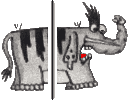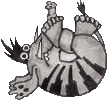
|
We place a spherical cage in the desert, enter it and lock it from
inside. We then performe an inversion with respect to the cage. Then
the elephant is inside the cage, and we are outside.
original. |

|
Without loss of generality, we can view the desert as a plane surface.
We project the surface onto a line and afterwards the line onto an
interiour point of the cage. Thereby the elephant is mapped onto that same
point.
original. |

|
Divide the desert by a line running from north to south. The elephant is
then either in the eastern or in the western part. Let's assume it is
in the eastern part. Divide this part by a line running from east to
west. The elephant is either in the northern or in the southern part.
Let's assume it is in the northern part. We can continue this process
arbitrarily and thereby constructing with each step an increasingly
narrow fence around the selected area. The diameter of the chosen
partitions converges to zero so that the elephant is caged into a fence of
arbitrarily small diameter.
original. |

|
We observe that the elephant possesses the topological gender of a torus.
We embed the desert in a four dimensional space. Then it is possible
to apply a deformation of such a kind that the elephant when returning
to the three dimensional space is all tied up in itself. It is then
completely helpless.
original. |